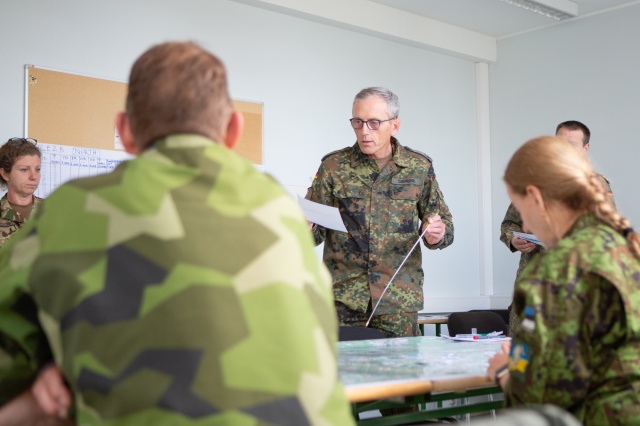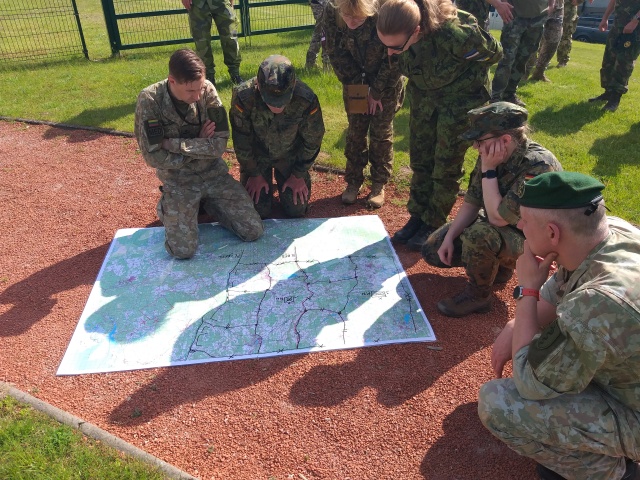
Article: NATO Advanced Medical Staff Officer Course (NAMSOC)
NATO Advanced Medical Staff Officer Course (NAMSOC)
Jürgen Muntenaar
NAMSOC – Working together starts with learning together! In 2019, during the NATO panel for Military Medical Training (MMT), the Estonian Military Academy (EMA) War & Disaster Medicine department (WDMD) approached the MMCC/EMC representative regarding training support. The question was if the MMCC/EMC would be able to support them with improving their advanced staff medical officer course (ASMOC).The old version of the ASMOC staff officer course was a rather theoretical lecture offered during a two-week course. Therefore, the Estonian Military Academy wanted to change it into a more interactive practice-oriented course.The two week ASMOC was the basis for captains/majors (OF2 / OF3) working at Brigade and Task Force Headquarters’ medical branches/ sections. However, given a shortage of staff and the course being outdated regarding its content and delivery, it was not delivered in the last 3 years. As training offers for this level is rare within most European NATO and EU nations’ medical services the MMCC/EMC participating nations supported that MMCC/EMC should support to develop a two-week hands-on training for medical officers and medical support officers (captain/major – OF2 / OF3) in collaboration with the EMA. After this training the participants could be employed as a staff officer in a brigade or a division headquarters medical cell/branch/division. The name chosen by the EMA was the NATO Advanced Medical Staff Officer Course – NAMSOC.The following principles were the starting point of the development of the NAMSOC:
1. Focus on NATO Art 5 operations at the lower tactical level (brigade/division);
2. Create an understanding of the tactical environment of NATO land forces to apprehend the medical support requirements;
3. Understand the function of a medical cell/branch/division to conduct the whole set of roles during scenario training and wargaming;
4. Limit teaching to 20%, use 50% for scenario-based syndicate work, 20% for wargaming of scenarios and syndicate products,10% for other topics;
5. Make the course multinational so students learn from eachother. EST and LTU provide 3 to 4 students each, other MMCC/ EMC member nations can send 2 to 3 students pending availability of places;
6. Use NATO doctrinal standards and best practices to bring students to a 80% standard knowing that the last 20% will cover the specific national topics and procedures.
The principles were applied in the course design and led to the following main Learning and Training objectives:
A. Understanding of land tactics at the brigade and divisional level(NATO ATP 3.2.1. – Land Tactics), e.g. understand how armies fight;
B. Understand how the military decision-making process (NATO APP-28 MDMP) at the tactical brigade/divisional level worksand what the contribution of the medical branch/cell is;
C. Understand the Command and Control (C2) of NATO landforces (NATO ATP 3.2.2. NATO C2 of land forces);

Planning for medical support of defensive and offensive brigade operations was part of the new NATO training for medical officers (source: MMCC/EMC)
D. Understand land logistics for land tactical operations;
E. Understand and apply the roles and responsibilities of a medical cell/branch/division of a lower tactical level (brigade/division) headquarters;
F. Understand and apply how to create and conduct a medicalsupport plan for a brigade/divisional defensive or offensive tactical operation.
In January 2022, the Estonian Surgeon General – Lieutenant Colonel Dr. Targo Lusti -dispatched a letter via the Chiefs of Medical Services in NATO (COMEDS), inviting nations to send participants to the first iteration of the NAMSOC organised from 7 to 17 June 2022. In May 2022, the core team from the EMA and the MMCC/EMC finalised the training program and resources. They also selected the participants for the first iteration and prepared the pre-course package.
During the selection process a number of senior officers (OF4/ OF5) were excluded as it turned out that they were not within the target audience for the NAMSOC. The precourse package with taskers for the accepted students was uploaded in the EMA ILIAS (Integriertes Lern-, Informations-, und Arbeitskooperation-System, German for Integrated Learning Managementsystem) learning portal which allows access from the civilian internet. All accepted students were informed about their acceptance and provided with additional administrative information, a tasker to conduct the pre-course package and access details for the ILIAS portal. During the conduct of the NAMSOC the overall program consisted of 5 phases. The first phase – being a 2 days’ introduction – consisted of the following modules: lectures on land tactics; headquarter functions and decision making; land & medical logistics; medical branch functions; role and integration in the headquarters. After this introduction phase, the participants were structured in 3 brigade medical branch teams. In this phase 2, each team was briefed on a scenario and received a brigade OPLAN (Operations Plan) for the first Multinational brigade (1 MN Bde) defensive operation with the task to create a medical concept for this defensive operation. During the planning phase, students had the opportunity to visit the actual Estonian battle space in which the scenario would take place. From the training/teaching staff 1 officer was attached to each team as a facilitator / mentor to help guiding them through the process of achieving the desired results. Phase-2: This being the first iteration with an OPLAN provides the opportunity for most participants to move out of their (medical) comfort zone and start understanding operational (land forces) language, abbreviations, tactical symbols, basic brigade and divisional headquarters procedures in the preparation of combat operations. The participants in each brigade medical branch team were given different functions ranging from the Brigade Medical Advisor, the medical planner, the medical operations officer, a Patient Evacuation Coordination Centre, medical logistics and force health protection/medical intelligence role. In addition, two persons were playing the role of the commanders of the brigade Role 2 and the brigade medical evacuation unit. The roles given were irrespective of former experience. They served as a means to making all participants aware of the whole range of functions that need to be fulfilled by a brigade medical branch/cell and the command & control that needs to be in place with subordinate brigade / divisional medical units.
During the finalisation of the medical concept for the defence of the simulated 1 MN Brigade the participants were able to visit the battle space of their brigade to discuss their concept but also to understand issues regarding the effects of terrain, weather, (battle) space and time, on the brigade OPLAN, the supporting medical concept and the required medical resources. During the visit in the terrain, we also took the opportunity to visit Voru County hospital. This hospital was purposely built as a former Soviet war- time hospital able to receive mass numbers of wartime casualties. The last day of phase 2 was used to wargame the brigade defence plan with the different supporting medical concepts as developed by the three brigade medical branches. Through the wargame each of the teams was confronted with the short- falls and strong points of their medical concept. The number of casualties admitted throughout the timeframe of the wargame was in line with the casualty estimate for this type of NATO Art 5 operation. The number of casualties and the distribution over time and space in the brigade area also provided an insight to the participants with regards to the effects on the resources available and the time required to dealing with the number of casualties. The first week of NAMSOC was closed with an evaluation and the details for the Saturday trip were shared with the participants. NAMSOC uses the opportunity to bring young medical service officers from other NATO nations to Estonia to experience working and living in a nation that is bordering Russia for two weeks. During the visit on Saturday, the participants travelled to NARVA to visit the border control post at NARVA bridge between IVANGOROD Castle (RUS) and NARVA Castle (EST). After security measures such as switching of cell phones the group was briefed and toured around by the head of the border post and a repre- sentative of FRONTEX, the EU border agency. This visit provided a lasting impression for the participants and made clear why we must educate, train and exercise our military and medical services in order to defend NATO territory and thereby our nations.After the border visit there was time to visit NARVA-Castle Museum and to have lunch. In the afternoon, a visit to the museum on the 1944 Battle of NARVA and the Tannenberg-line was undertaken. Both battles took place between the Russian Leningrad front armies and the German Army group North from February to August 1944. Upon arriving in Tartu again the day was closed with a course dinner.
Sunday afternoon was the start for phase 3 in which the participants started with preparatory study and lectures on the tactics, logistics and medical factors for offensive activities at lower tactical level. After understanding these topics, the participants were again submerged into the tactical scenario on Monday afternoon which was the start for phase 4, the development of a medical support plan for a brigade counterattack. During this phase the participants were not only required to develop the medical concept for the brigade OPLAN but were also expected to write an appropriate medical annex, coordinate their planning with the divisional medical advisor and the brigade medical advisors with which they would conduct a forward passing of lines. Finally, each of the brigade teams was ordered to be ready to briefing the division medical advisor on their concept for medical in support of a brigade counterattack.

The course participants during one of the exercises on land tactics, defensive and offensive operations and medical support for large-scale military operations (source: MMCC/EMC)
During phase 4 the teams saw that all complex elements of planning and preparing for the medical support of offensive activities with regard to battlespace coordination, time, resources and appropriate command and control were addressed. Above all, the teams were pushed to provide a timely Annex R Medical for the brigade OPLAN. Hence, they needed to work together and organise their work as efficiently and effectively as possible. In the evening, the final products were reviewed by the facilitating/ teaching staff to provide feedback the following morning. Based upon this feedback the designed medical plans were put on the wargame maps for wargaming.
The last course day (phase 5) was used for some lectures on specific topics such as the Geneva conventions, law of armed conflict, a lecture on multinational cooperation by Dir MMCC/EMC BG Kowitz, a brief by the Ukrainian Surgeon General covering the military medical challenges on the Ukrainian battlefield. In the afternoon the participants that graduated got their graduation certificates, if they passed the evaluation successfully. The graduation certificate also provides 3 ECTS by the Estonian Military Academy.The evaluation of the training course by the students was excep- tionally positive and the remarks for improvement have been incorporated for the latest NAMSOC iteration from 12 June to 22 June 2023 at the Estonian Military Academy in TARTU.
Author:
COL (OF-5) Jürgen Muntenaar (NLD)
MMCC/EMC Deputy Director on NATO matters
Andernacher Straße 100, 56070 Koblenz
Date: 04/24/2024
Source: EMMS Magazine 2023











